Corsica’s wild landscape has been drawing travelers in for decades. Its rugged mountains, white sandy beaches and turquoise waters provide the perfect mix of relaxation and adventure, while its Indigenous culture and rural traditions make it one of the most unique destinations in Europe. However, half of the island goes undiscovered by most tourists visiting the Île de Beauté.
While Corsica is officially divided into Corse-du-Sud and Haute-Corse, I like to draw a line between East and West. As the towering mountains make up most of the terrain, driving across the island takes a long time. The Routes Territoriales – or the main roads – mostly run on the coastlines, with only one crossing the island from Borgo near Bastia to Ajaccio. Most people therefore tend to stay on one side of the island.
The Western coast has also been more popular due to its Saint-Tropez-like boating-tourism and impressive coastal cliffs. Despite its charm, my family and I have been visiting Eastern Corsica for over a decade and truly believe this side of the world should not be missed. With this East Corsica travel guide I will therefore be telling you where to go, and where to stay and what to do in each destination. Prefer to see the entire island? Then read my 3 week Corsica itinerary.
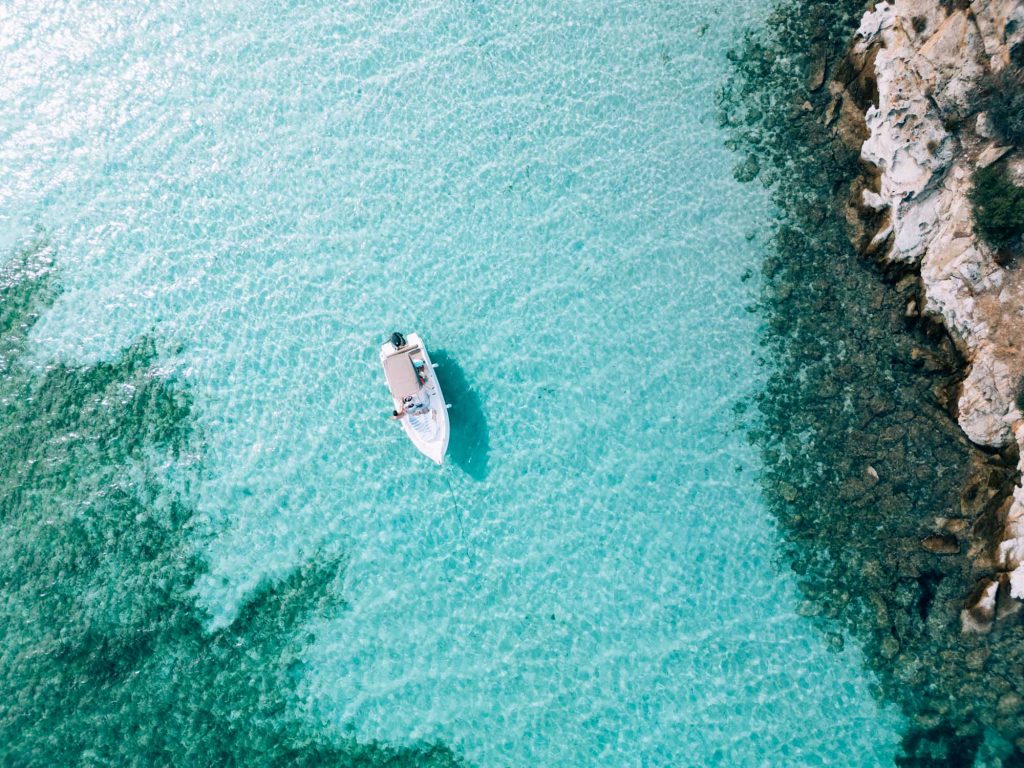

How to Get There
This East Corsica travel guide would not be complete without telling you how to get there, especially when the journey is part of the fun. There are two options here: driving and taking the ferry or flying into one of Corsica’s airports.
You can take the ferry from Savona, Genua, Livorno and Piombino in Italy and Marseille, Toulon and Nice in France to multiple ports on Corsica. The main two ferry companies are Corsica Ferries, which is what we used to sail with, and the Moby Lines, which we sailed with once and had a Looney Tunes theme at the time. The last one is therefore perfect for kids!
Tip! Book a couple of nights in Italy before taking the ferry, to spread the journey and eat some pasta.
What’s more: on most ferries you can book an overnight trip including a cabin, which I prefer to sailing during the day. The sail is usually calm enough to sleep through any turbulence on board and will allow you to see the Corsican shore in the morning light. Check your route here to find the best prices, ferry line and dates for your trop.
Another, and quicker (albeit less fun), option is to fly into Corsica. While Corsica has multiple airports, Bastia’s has the best location when traveling through Eastern Corsica. The recently renovated highway connects to much of the eastern shore, and the city is close enough to the north if that is where you will start your trip. Last year, we found the cheapest fares through Skyscanner, which is one of my favorite travel tools! Find your flights here or check your dates below.
Public Transportation
Corsica is home to one of the most beautiful train routes in Europe and should not be missed when you are a train travel lover. It is called the U Trinighellu (small train) and runs between Ajaccio and Bastia. The train takes you through the mountains and offers spectacular views. However, I would only recommend it if you have enough time on your hands and if your route is mostly located around the train track. This route is namely the only train connection on the island, quite slow and its departure times can be unreliable.
The final mode of public transport in this East Corsica travel guide are buses. These are often used by locals and run between most towns. However, they usually only run once or twice a day on longer distances and their timetables change frequently. If you plan on traveling mostly via public transport, I recommend asking the tourist office or your hotel for the latest news and departure times, so you do not get lost. If this all sounds too complicated for you, keep reading to find the best way of getting around below.
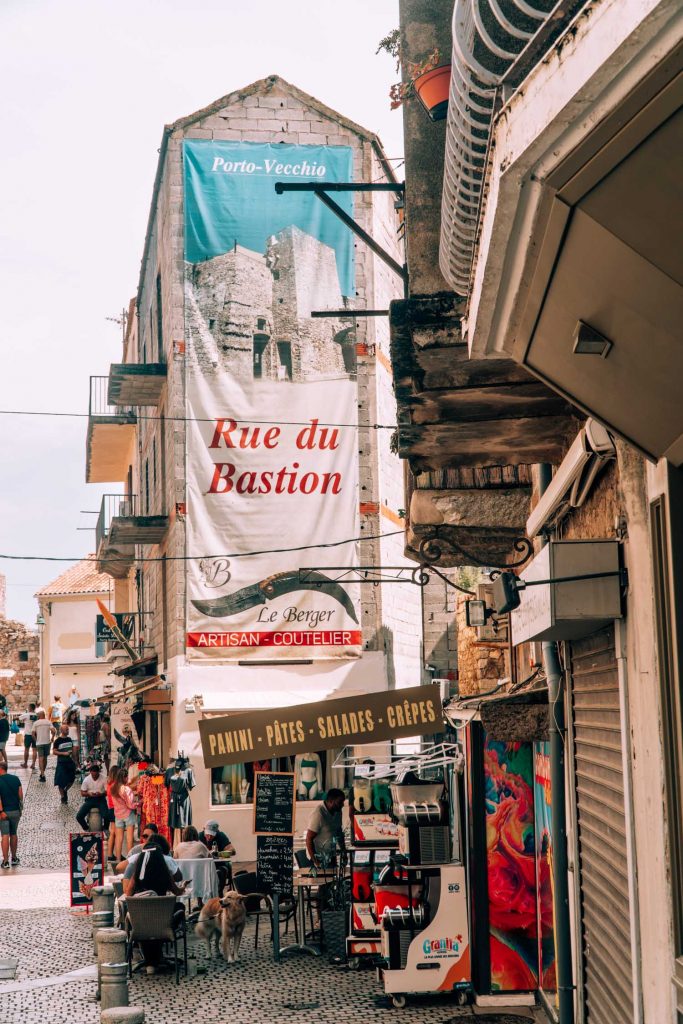

Why Renting a Car is a Must
The best way to get around Corsica is by car. Public transport tends to be unreliable and many destinations, especially the hidden gems in this East Corsica travel guide, are remote. Renting a car – or taking your own car via ferry – is the easiest way to get everything out of your travel experience.
It is important to note, however, that most of the roads are not for the faint hearted. Often narrow, with steep drops on the side and sharp switchbacks, being a confident driver is a must. But when you do brave these mountainous roads, you get epic views in return. Driving through Corsica is a wonderful travel experience in itself. Do be cautious of blind corners, as locals, who know these roads like the back of their hands, tend to drive a lot faster and cut corners.
Tip! The best way to see Corsica is to go on a roadtrip, for which I crafted the ultimate 3 week itinerary.
You can rent your car via DiscoverCars, which allows you to compare multiple rental agencies and thus find the best prices. If you get sweaty hands thinking of driving through the mountains however, I recommend renting an automatic instead of a manual car, so you can fully focus on the road and not worry about switching gears on an incline. Check the best car for you right here, and then let’s get back to this East Corsica travel guide.

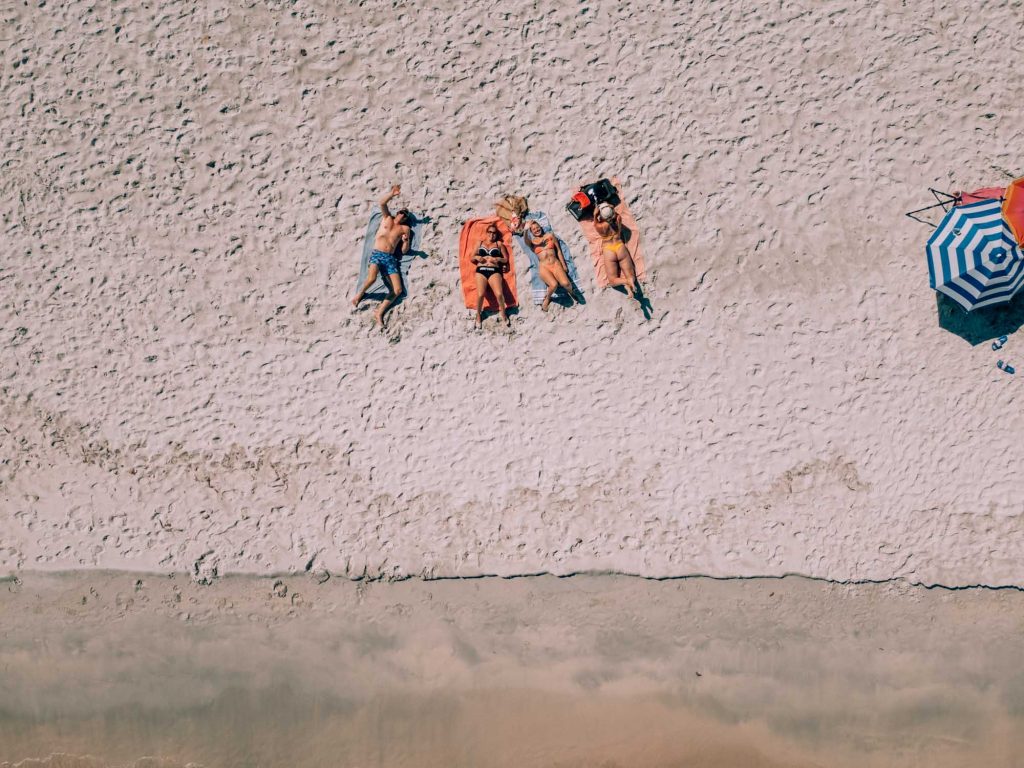
Where to Stay
If you know me, you know I love a good hotel. Good design incorporating local features and comfort plus lovely hosts can take any stay to the next level. So, while I will be telling you where to stay in each destination listed in this East Corsica travel guide, I will be sharing three of my best finds right here.
Going from north to south and beginning in Saint-Florent, you can find the gorgeous Hôtel la Dimora. Located in a former farmhouse, which used to produce olive oil, fruit, grain and dairy, it combines designer with antique furniture. Its exposed stone walls offer the charm you are looking for in a Corsican hotel, with the restaurant in the old sheep pen as one of its most stunning features. The hotel as seventeen rooms and two villas with a private pool, with the hammam spa and a large offering of massages as the cherry on top.
Another one incorporating Corsica’s natural elements, Dominique Colonna offers rooms with views of the river and the mountains surrounding Corte. With a heated pool and even a yoga and pilates studio it is the perfect place to relax after hiking in Corsica’s rough mountains. Prefer more adventurous exercise? Then you can rent an e-bike to explore the area around the fortified city.
Finally, located in the mountains surrounding Porto-Vecchio, Domaine de Casanghjulina has dedicated itself to be as sustainable as possible. Which translates itself into the way the hotel has incorporated nature. You can book tree houses here that have their own private outdoor baths, stay in their traditional stone cabins or enjoy your stay in the main building. This last hotel in my East Corsica travel guide is perfect for travelers looking to mix luxury with their love for the outdoors.



East Corsica Travel Guide: 10 Must-See Destinations
This East Corsica travel guide mainly lists the best destinations, but it can also be used as inspiration for your itinerary. Assuming you arrive in Bastia and have a car, your first destination will not be the city itself, but Saint-Florent. From there you go further and further south, until you reach Porto-Vecchio. Curious? Then keep reading!
1. Saint-Florent
Often compared to Saint-Tropez, Saint-Florent’s quaint streets and glamorous port could truly be its little sister. While the town was founded by the Genoese Republic to protect its colony’s shores, its citadel is now a tourist attraction overlooking wine bars, cute shops and luxe sailboats. It is the perfect town to start your Corsican adventure from as it is small enough to explore within an afternoon, and has the exact amount of vacation vibes you seek at the start of a holiday.

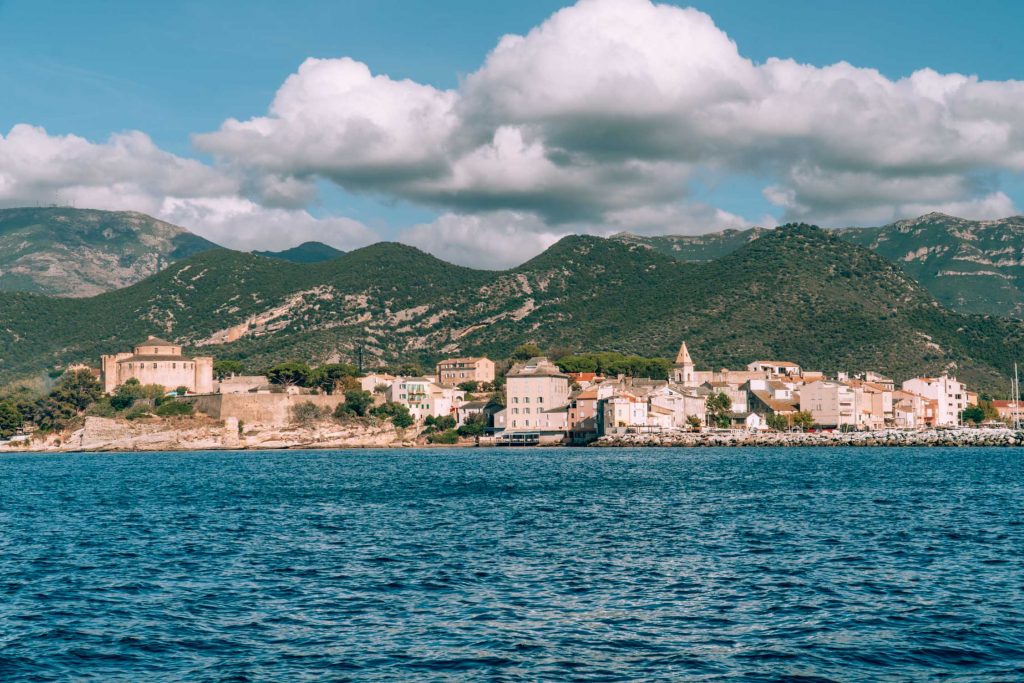
What to Do in Saint-Florent
Within the village itself, besides many great bars and restaurants, two sights catch the eye. First, the Romanesque Nebbio Cathedral overlooking the city, which was built when the town was still called Nebbio. Of its former form only this cathedral remains. Second, you must visit the Genoese Citadel, which cannot be escaped when wandering around the city.
However, the best thing to do in Saint-Florent is to book a daytrip on a sailboat which will take you to the gorgeous beaches surrounding the villages bay. We went with Sailingmaures and had the best day hanging out with their adorable dog Tixie. The main attraction of the day? The cow laying down under someone’s parasol on Plage du Saleccia. The company was run by a young couple from Corsica who were saving up to sail around the world. So, if you plan on sailing, book a tour with them to support them on their travels!
Tip! If you are celiac or gluten intolerant like me, make sure to clearly communicate your dietary needs beforehand, so they can cater to your needs.
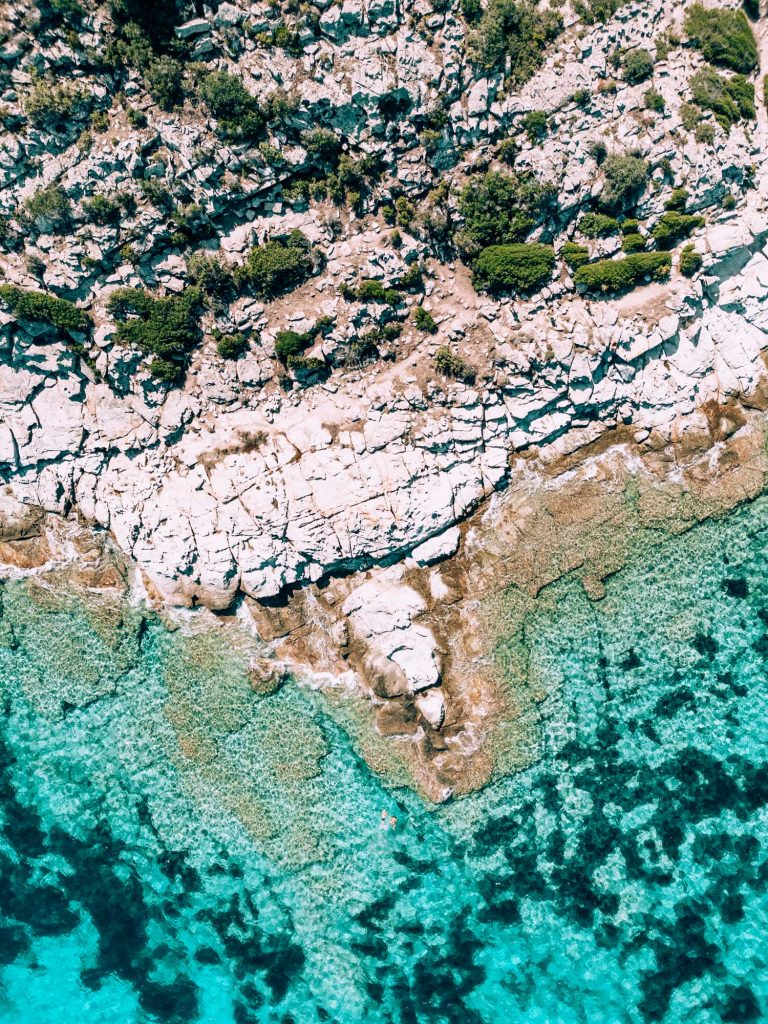

Besides fancy boat trips, the nature around Saint-Florent is gorgeous as well. Consider visiting the Desert des Agriates, Corsica’s “desert” covered in lush maquis, which is only accessible by foot or a 4X4 jeep tour. While you technically visit the nature reserve if you go sailing, the Agriates reach far beyond the pristine beaches. Want to experience gorgeous nature, but without the dayhike? Then visit the botanical gardens of Parc de Saleccia, where you can enjoy dinner at the restaurant as well.
Tip! Wine tasting is a must-do here, so check out my Ultimate Corsica Wine Tasting Guide
Finally, the area around Saint-Florent is known for its great wine, with its neighboring village Patrimonio being the star of the show. While I will share my favorite vineyard below, I suggest doing a wine tasting and tour on a vineyard between Saint-Florent and Patrimonio. Nothing says summer holiday more than some good wine by the sea!
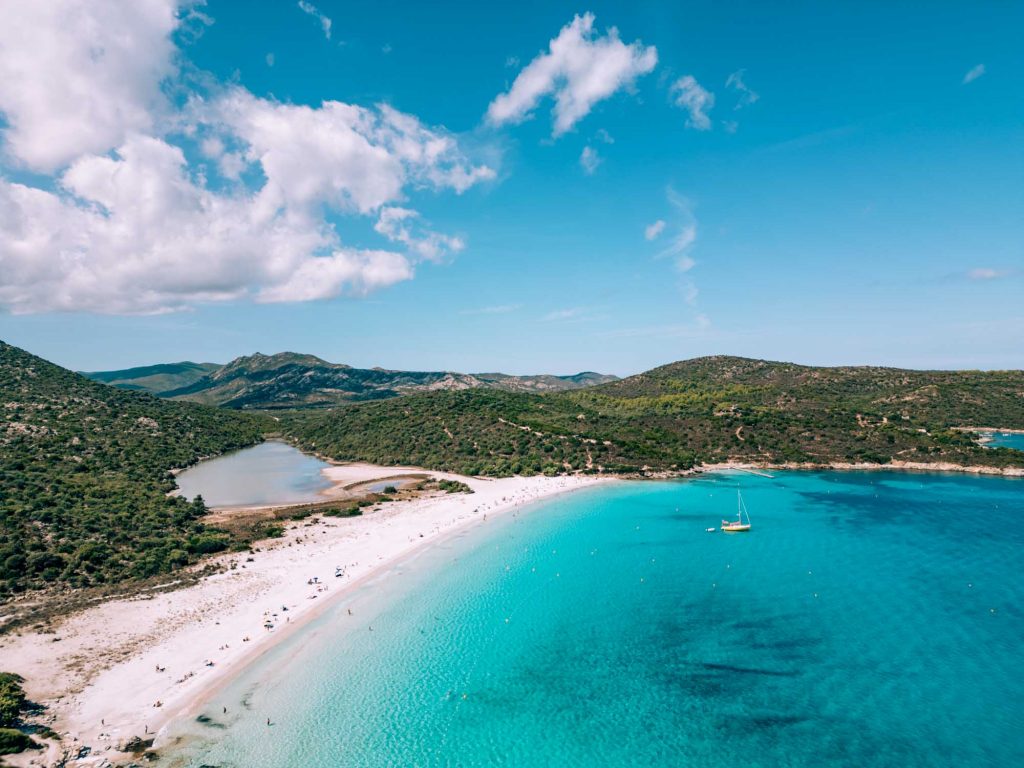
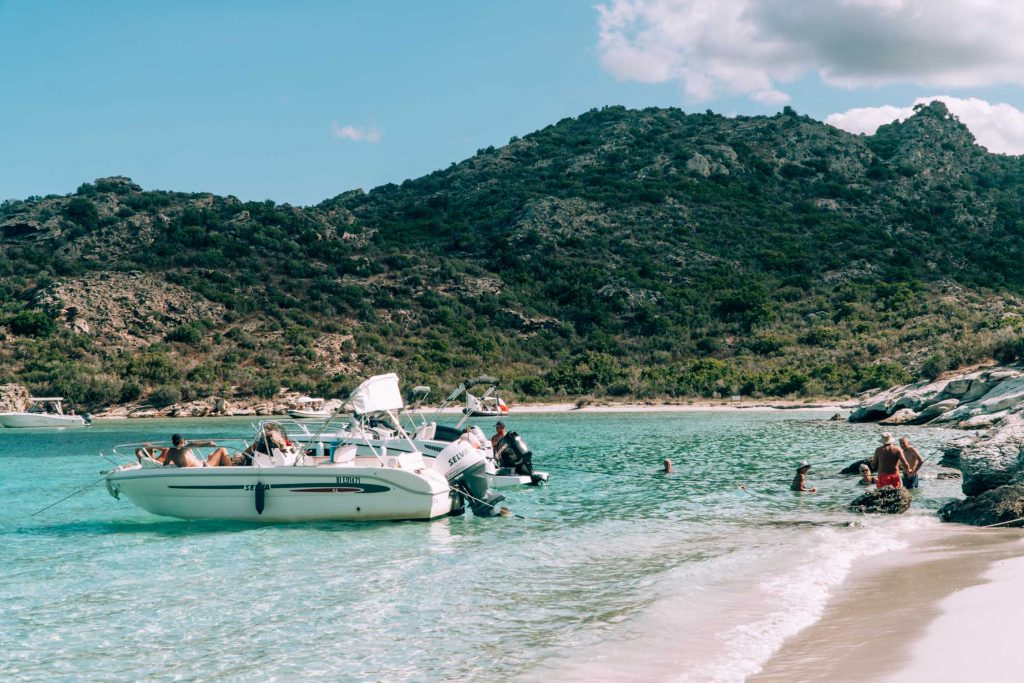
Where to Stay in Saint-Florent
I already mentioned Hôtel la Dimora, which would be my number one go to if I had some money saved up. If you fancy staying in the center of the village, I suggest Hôtel & Résidence San Roccu, which offers apartments as well. More on the budget side is Hôtel Sole e Mare, situated on the beach with rooms overlooking the garden or the ocean.
2. Cap Corse
If you imagine Corsica to be a foot, then Cap Corse is its incredibly long, big toe, or just a peninsula if you are more normal than I am. Known for fishing villages and its rugged coastline, this part of the island is often overlooked. While it does not offer the same glitz and glam as much of the larger towns to the South, Cap Corse is full of history and beautiful nature: ideal for lovers of the outdoors.


What to Do in Cap Corse
Cap Corse is full of lovely fishing villages and Genoese watchtowers, which were used to protect Corsica’s northern shores. While the towers are too many to name, there are a few villages that offer that perfect charm and classic seafood. Erbalunga is just like a painting: with its houses right on the edge of the water, neighbored by the Genoese Torra d’Erbalunga.
Centuri lies to the north-west of Erbalunga and is still busy with fisherman bringing in their wares. Its pastel-colored houses are therefore a charming backdrop while eating fresh lobster in one of their local restaurants. Once your belly is full, head over to the village Cannelle, which offers majestic views of Centuri and the sea.


Further south on the western coast of Cap Corse, which harbors even more steep cliffs than the eastern side, you can find Nonza nestled in the hills. The most stunning part of the village? The black beach below it called Plage de Nonza. But besides this extraterrestrial site, Nonza is full of history. Visit the Castle of Sassa or the San Francescu Monastery for a deep dive into medieval Corsica.
Once you are sick of village hopping, you can head over to one of the many hiking trails on Cap Corse, the most popular ones being the Sentier des Douaniers, which was used in the past to check and rid the coast off smugglers, and the path leading up the Monte Stello, the highest mountain of Cap Corse.
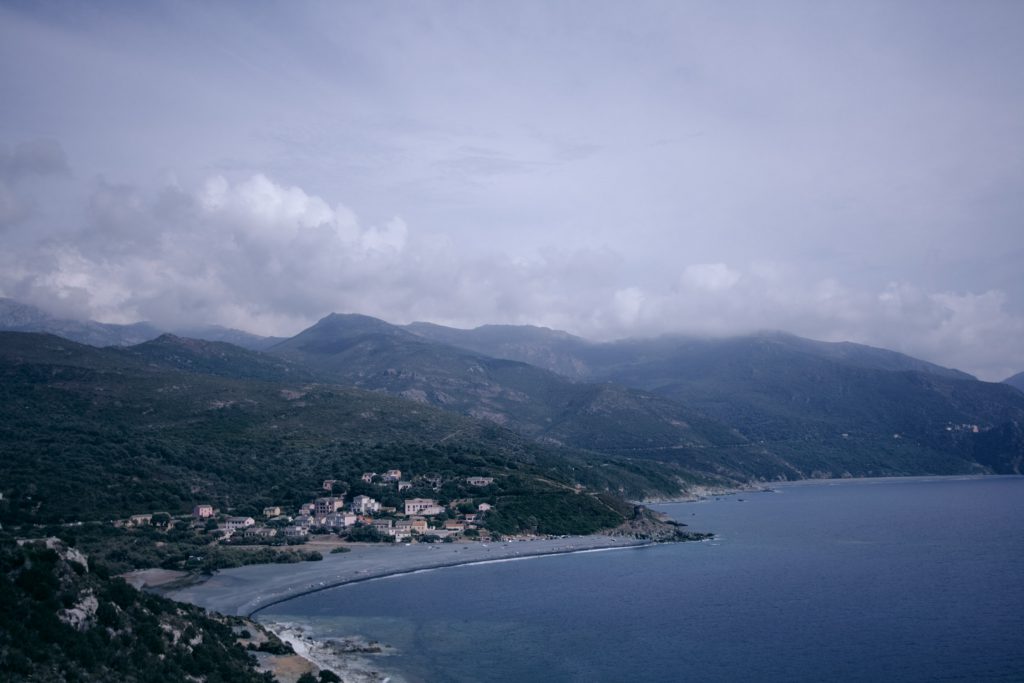
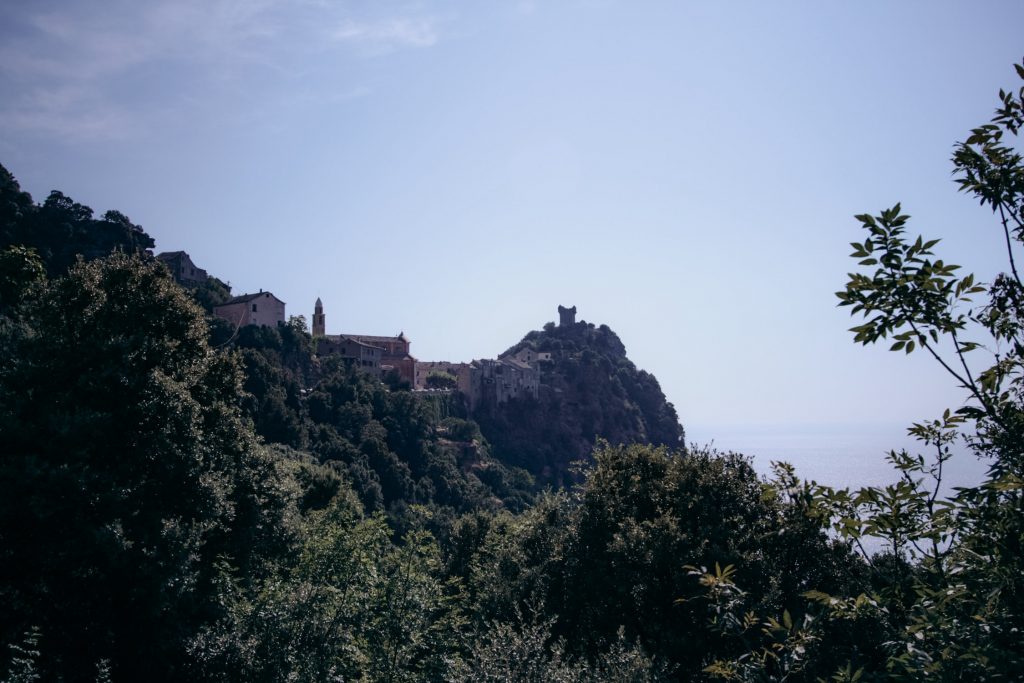
Where to Stay in Cap Corse
Want to get pampered? Then stay at Misincu, one of the top hotels of Corsica located in Cagnano. It has got everything: a resort-vibe pool, views of the sea and relaxing rooms. More in the mood for a rural and budget-friendly experience? Then the U Sant’Agnellu is the right fit. Located in the medieval village of Rogliano, it has got views of both the ocean and the mountains. Completely charmed by Centuri? Then stay at Hôtel de la Jetée, right at the heart of the adorable fishing village.
3. Bastia
Most travelers treat Bastia as a transit town, which is a shame. As the former capital of Genoese Corsica, Bastia has a lot of history to uncover. Now the capital of the Haute-Corse region and the island’s second largest city, Bastia is home to amazing restaurants, countless Baroque churches and a vibrant old and new port. Spend at least a day or two here to get to know more about Corsica’s history.
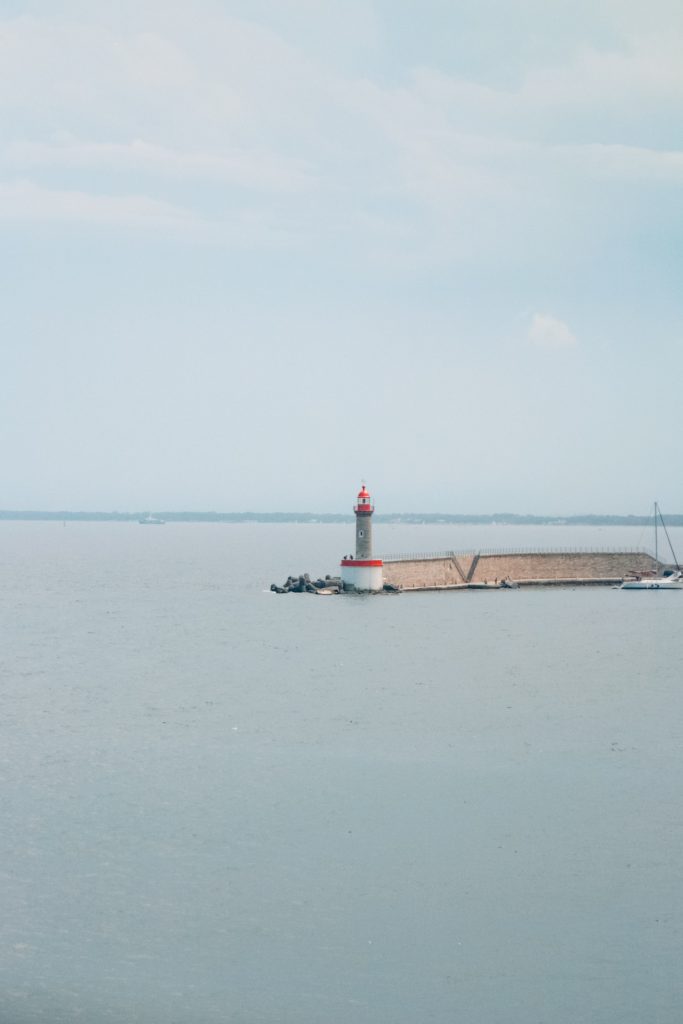

What to Do in Bastia
Because Bastia is full of historical sights, like the Saint-Marie Church and Palace of Governors, one of the best things you could do here is book a guided tour. From the Genoese period to the impact of the First and Second World Wars, these private tours led by locals will explain the rich history of Bastia much better than I ever could. Furthermore, Bastia can feel a little overwhelming and hard to navigate. A tour will make it much easier for you to fall in love with the city!
Second, food! Hazelnuts, brocciu cheese, and charcuterie infused with maquis spices: what better place to explore authentic Corsican cuisine than in one of its largest cities? Next time I visit, I would love to do a guided food tour here. Not only because Corsican food is superb, but I also believe food to be the gateway to a place’s culture. Don’t forget to send me pictures once you booked your tour, as I would love to see what you tasted.
Finally, something I would not do in Bastia is visit its beaches. Not because they are not stunning, but because I think that time is best spend in the more remote areas of the island.
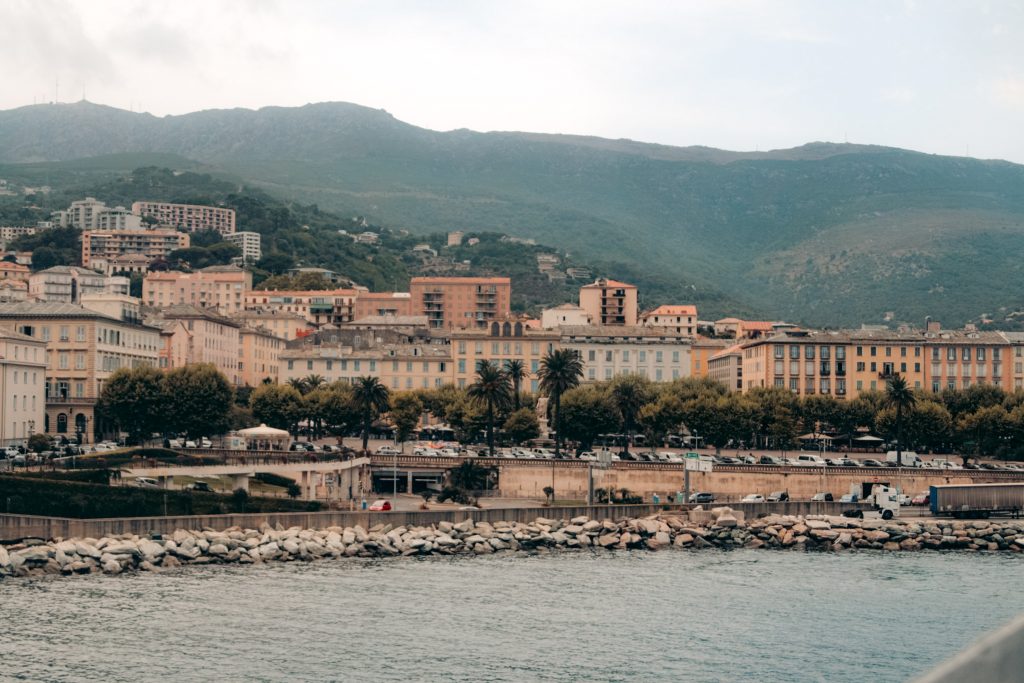

Where to Stay in Bastia
Have I got a hidden gem for you! Right in the center of Bastia, Hôtel Des Gouverneurs is the perfect place to soak up the ocean views. With classically designed rooms, an indoor pool and spa, this is the perfect hotel to unwind after a long journey. Another hotel with a great location is Babbu Hotel, with a classic interior. If you would like to stay somewhere a bit quieter however, then consider staying at Alivi, which overlooks the water and has a gorgeous pool.
4. Corte
Corte is one of my favorite cities on Corsica, and soon it will be yours too. Why? Because you cannot see the citadel perched on a cliff without falling in love with the view. It is the heart of Haute-Corse and the island’s university city. As the gateway to much of the island’s mountains, Corte is the perfect destination to experience mountain life and start your own hiking adventure from.


What to Do in Corte
Corte itself is worth spending a day or two in. A must see is the Citadelle de Corte, which forms the heart of the city. Within the Citadelle, you can visit the Musée de la Corse, where the permanent exhibition tells the story of Corsica’s civilization and you can find other temporary exhibitions all year round. Want to view the Citadelle from the outside, however? Then you must visit the Belvedère viewpoint, which has 360 views of Corte and the mountains around it.


Once you have got your dose of culture, it is time for some outdoor adventure. Last year, we visited the Gorges de la Restonica for an easy hike to the mouth of the gorge. Multiple tougher and longer hikes depart from the Restonica valley, like the hike to Lac de Melo or Capitello, or you could choose to explore the gorge in a wetsuit. Canyoning is a common activity on the mountainous isle, and the Gorged de la Restonica is no different. Book a canyoning tour starting from nearby Venaco to make your stay in Corte even more memorable.


There are many more hikes to discover, if you prefer your mountain experience dry. Lac de Nino and Monte Cinto (from Lozzi) can both be reached from about an hour drive from Corte. If you must choose one, the hike to Corsica’s highest mountain (2706), Monte Cinto, should be your pick. However, the pozzis – lush marshland flecked with clear lakes – surrounding Lac de Nino were one of my favorite parts on the GR20 years ago, and must be on anyone’s bucket list.
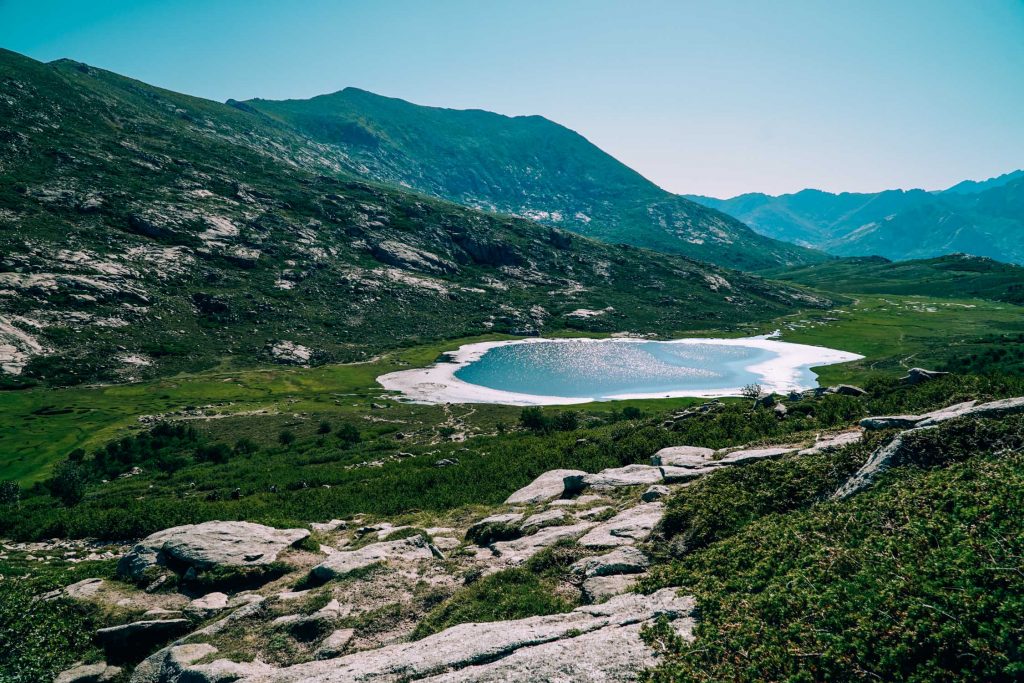

Where to Stay in Corte
Dominique Colonna will stay my top-pick for Corte, but the city has a lot more to offer, and that for any budget. If you like your own space, the ability to cook your own Corsican meal and not spending too much on accommodation, then Apartment Padova T2 by Interhome should be your pick. Maison San Giovanni is located in the hills, but on walking distance from Corte, and has a host that many guests describe as attentive and a great cook. A must-stay if you ask me!
5. Aléria and the Belly of the Island
Lovingly called the belly of the island (by me), Aléria and its surroundings offer relatively flat lands for crops to grow and vineyards to thrive. The village used to be the capital of the isle when it was still under Roman rule. Right now, only the archeological site reminds visitors of that time, the rest of the village offering a quiet respite from the long beaches the east coast is known for. Still, the area around Aléria has a lot to offer and should not be passed on your way down south.
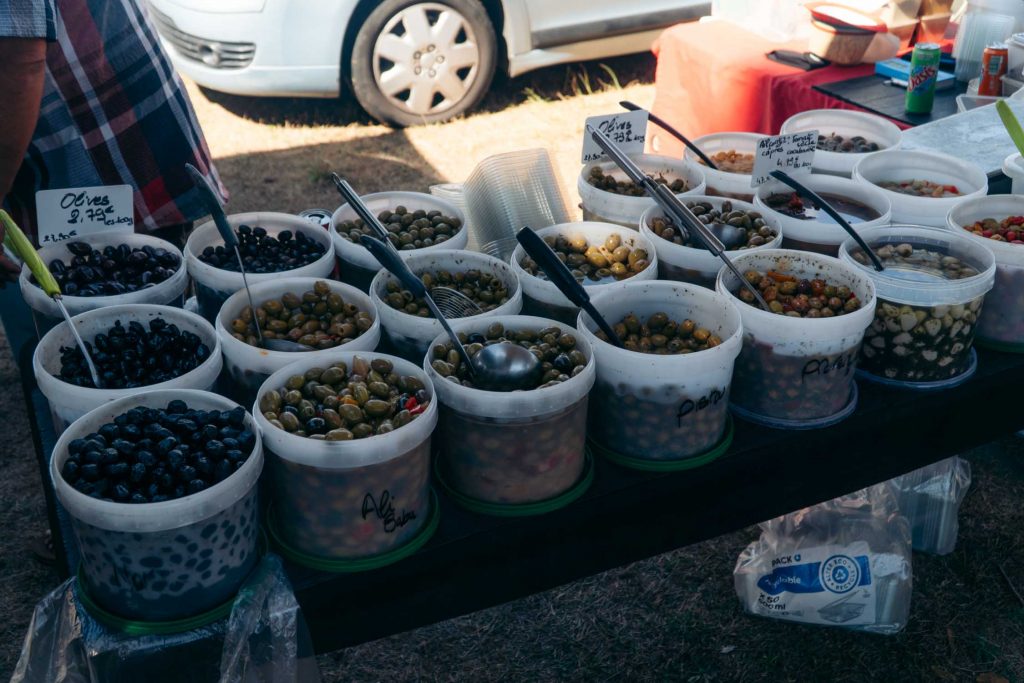

What to Do Around Aléria
In Aléria itself you can visit the Roman Ruins – le site archéologique d’Aleria – and its corresponding museum, which is located in the stunning Matra Fort. Built, you guessed it, by the Genoese. The rest of the ruins date back to 200 and 100 BC, and showcase what used to be the city’s forum, its thermal baths and local shops. Definitely worth your time when you are a history buff!
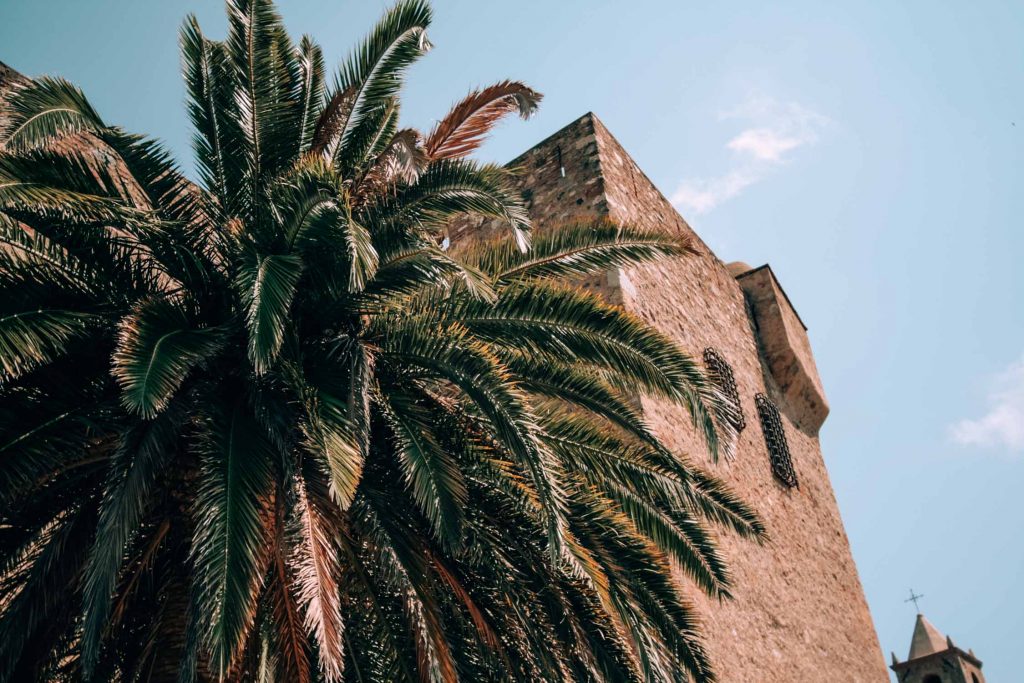

Personally, I am a foodie and would therefore choose a good food experience any day. The number one tip I will give if you love seafood: book a table at Aux Coquillages de Diana. The restaurant is located in a bungalow built over the water of the Étang de Diana, the coastal lagoon bordering Aléria, and serves fresh fish and the best oysters you will ever taste.


Besides great food, the Étang de Diana and its neighbor Étang de Urbino offer impressive hiking trails and a unique ecosystem, including thick maquis and breeding, endangered birds. Spending some time near these special lagoons is thus a must for nature lovers and bird watchers.
Continuing with our food tour, wine is omnipresent on Corsica and the island has some special flavors to offer. While you can do a wine tasting near Diana at Domaine de Terra Vecchia, we visited eclectic Clos Canereccia. The family business grows Corsican grapes on 20 of their 22 hectares, and does everything organically, but also a little differently. Our wine-tasting host decided we would start with the red wines and finish with rosé, something I will not do again (better to start with rosé and white), but he sure made us laugh! The wines themselves were incredible, though, and we took as much home with us as we could.
Tip! Clos Canereccia is not the only vineyard on the island, check out this guide for the best wine tasting spots on Corsica
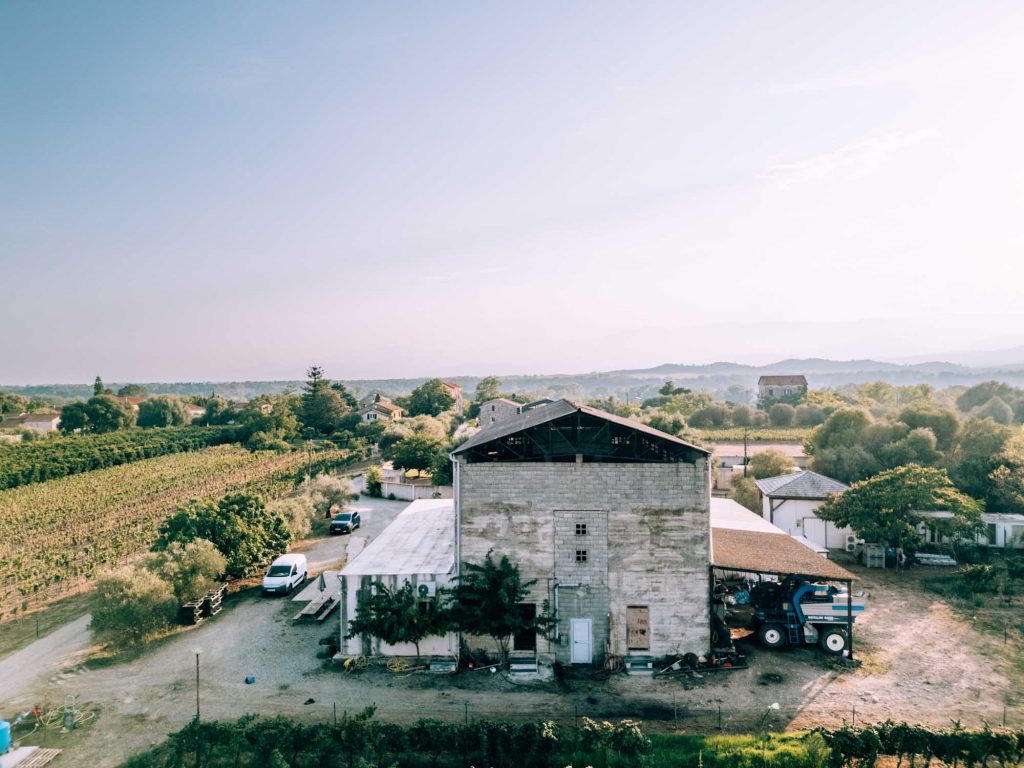
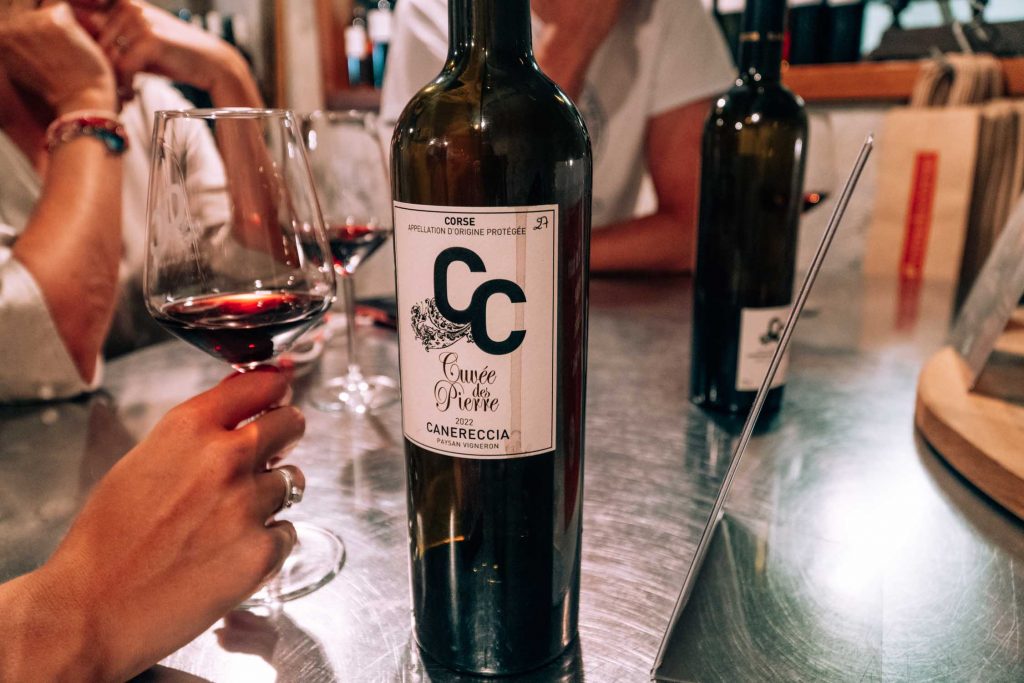
Finally, a must when staying in Aléria is to visit the weekly farmer’s market in Bravone. Every Thursday local artists and artisans flock the market to sell their wares, whether it be paintings, jam, cheese, pastries or jewelry. Every time we visited Corsica, we stayed on a camping near Aléria, and this market was a must-do during each holiday. When we visited again last year, it did not disappoint!

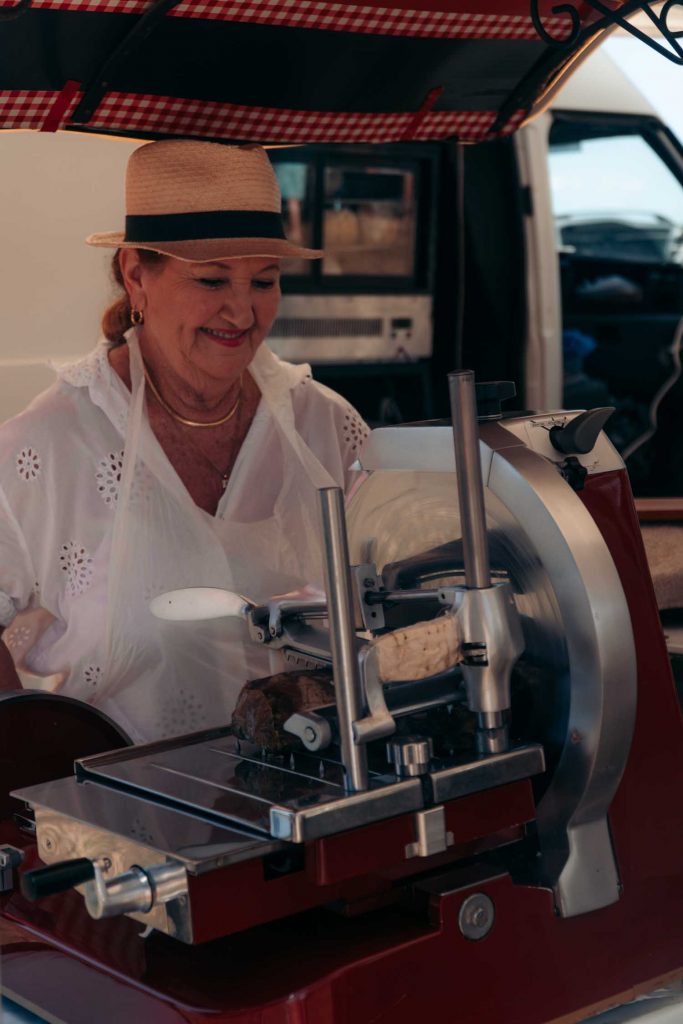
Where to Stay in and around Aléria
The area around Aléria is known for its nudist campings and beaches, and therefore has two great options if you are into that. Both Bagheera and Riva Bella offer chalets and areas to pitch your tent in between the gorgeous Corsican pines. The latter has a spa, while the first offers yoga and pilates. If you prefer to keep your clothes on, however, I recommend staying at Résidence Marina Di Bravone, where you can rent an apartment overlooking the ocean, or rent your own villa at the Demeure de charme Suarella Domaine de Marquiliani.
6. Conca: Start of the GR20
In 2017 my father and I walked the southern part of the GR20 and in 2018 we almost finished the rest of the trail. While most people walk the hardest multi-day hike of Europe from north to south, we chose to go the other way around to have the sun at our backs and start with the ‘easy’ part. This meant we would start in Conca. While Conca itself is very small, if you are an avid hiker, the GR20 is huge and a bucket list item for sure.


What to Do in Conca
Église de Conca, the village’s church, is the only sight that has made Google Maps. The rest of the village is dedicated to the start of the Grande Randonnée 20. If a fifteen-day hike sounds too much for you, you could hike up to the Bocca d’Usciolu and circle back down to the village from there. If you are not a hiker at all, then hop over to destination eight.


Those looking for the ultimate challenge are right where they should be in Conca. The first étappe of the GR20 leads you over the Bocca d’Usciolu – a 1200m climb – to the Refuge de Paliri in the Col de Bavella, a challenging climb and a great reality check. The GR20 should not be taken lightly, and it is advisable to prepare yourself well for this trek. Not only by getting fit, but also by doing some climbing or bouldering lessons. Hands and knees are sometimes required to get over steep parts, as well as proper shoes, poles and lots of sunscreen.
There is much more to consider when starting the GR20, but the views and experiences you get along the way are totally worth it. Let me know in the comments if you want me to do a full guide on the GR20!

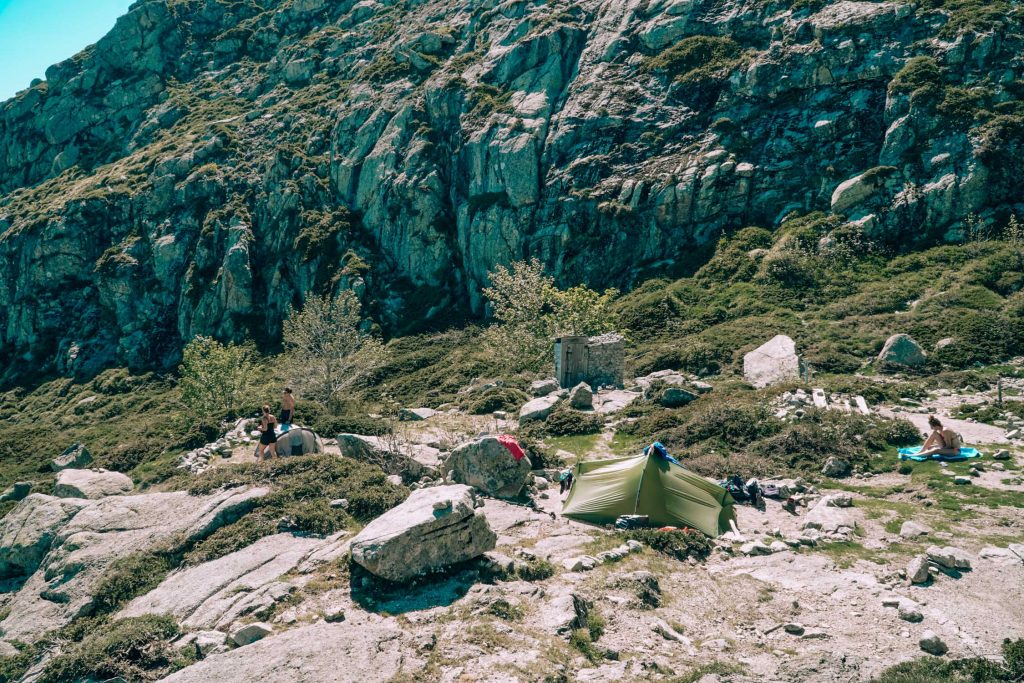
Where to Stay in Conca
We stayed at the Gite de la Tonnelle, a simple cabin with good food and great service. Everything you need the night before your hike. Most of these gites cannot be found via Booking.com and are best booked via phone or their own websites. If you are looking to pamper yourself before the start of your trek, however, I suggest the villa Casetta Conca or the Casa Suvara. However, these are probably best to book for more than just one night, simply because they look too good to not properly enjoy.
7. Aiguilles de Bavella
This is one of my favorite hiking areas on Corsica, with trees formed by decades of hard wind and the most impressive rock formations. Bavella has an unforgettable landscape, and fickle weather. Hiking here is best done early in the morning and afternoon, as the summer can bring dangerous thunderstorms with it. But when the sun is shining, this is one of the most beautiful places on Corsica.
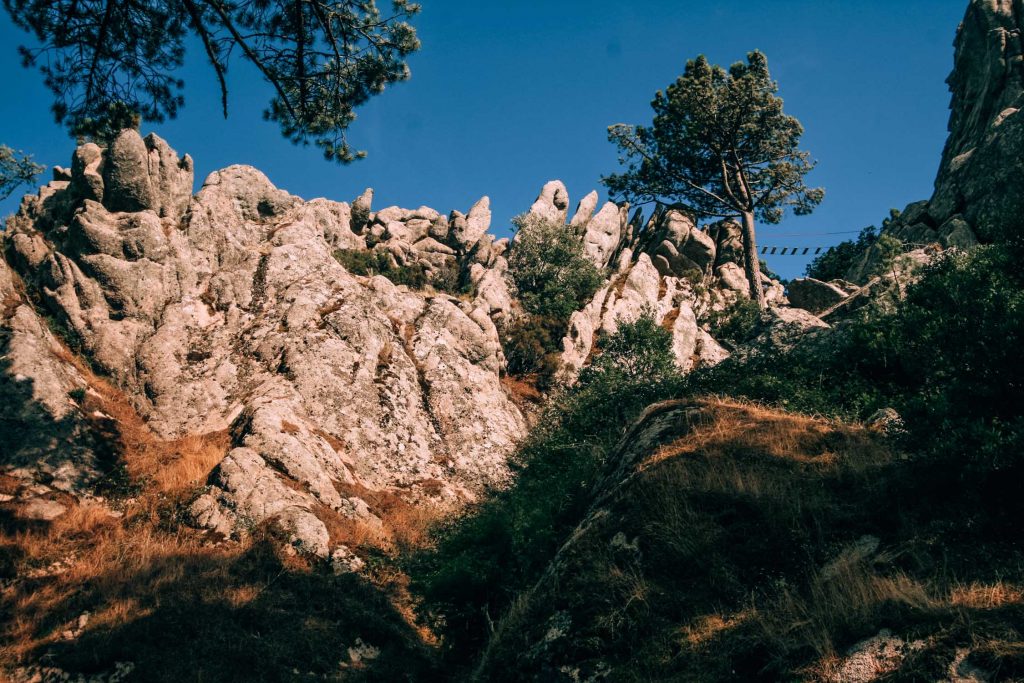
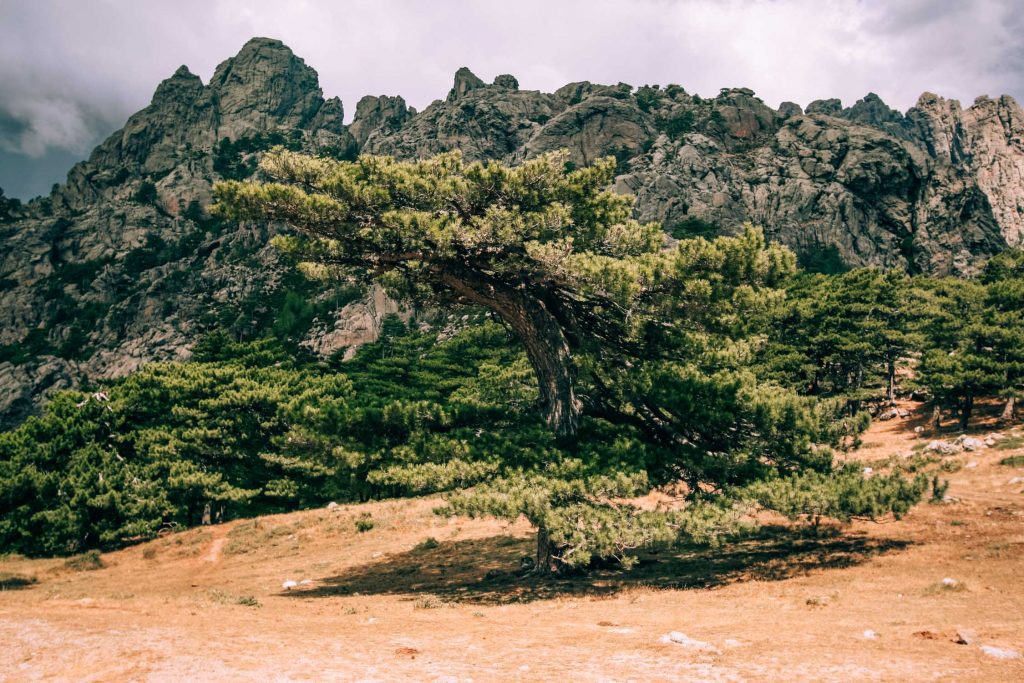
What to Do in Aiguilles de Bavella
The most popular hike in Bavella is the Trou de la Bombe, or U Tafonu di u Cumpuleddu in Corsican: the hike to the hole in the mountain. The hike itself to and from the Trou de la Bombe takes about three hours and is loop-shaped, meaning you do not have to take the same way down. The hike itself is relatively easy, with most of it crossing the pine forest. Follow the red marks to stay on the trail, or book a guided tour to learn more about the ecosystem around you.
But just the site of Bavella itself is worth a visit. With panoramic views all around, you can walk to the Croix de Lecca to enjoy Bavella’s landscape. This hike is harder than the one to la Bombe due to its rocky terrain, however, even though it is an hour shorter. Follow the green marks for this one.


The final big hike you can do from here is the climb to the Refuge de Paliri and back, which is the first (or last depending on your starting point) stop on the GR20. This hike takes you to beautiful panoramic views and is relatively easy, although you will be ascending 400 meters in total. The hike to the refuge and back takes about four hours. You should follow the red and white GR20 marks to reach the hut, just make sure to turn back!
And if you do not like hiking at all, but do love nature, you can also book a 4×4 tour which will take you offroad in both Bavella and the Ospedale Forest. The tour leaves from Porto-Vecchio – the next destination – and is a less physical way of seeing the surroundings of Bavella. However, I still believe the best way to experience nature is to be immersed in it, instead of cooped up in a car.

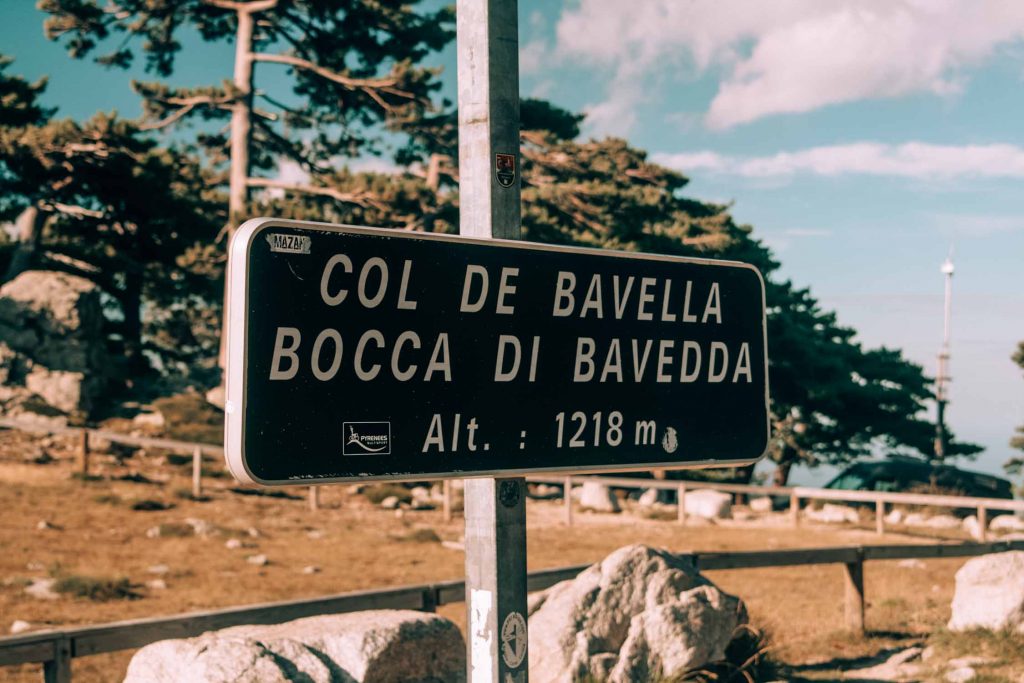
Where to Stay in Aiguilles de Bavella
If you choose to stay in the village of Bavella, the best thing to do is book a room at a refuge or gite by phone, as most cannot be found on Booking.com, except for Casa Jeromine. Most of the hotels are spread out over the area surrounding Bavella, like this special stay in the old wooden wagon of Roulotte insolite U tragulinu or stay at the more luxurious Les Hauts de Cavanello, which has a pool. If you are in the mood for a little longer drive to Bavella village, then you cannot miss out on a stay in the ecotourist Cocoon Village which consists of transparent dome shaped tents from which you can stargaze at night.
8. Porto-Vecchio
Porto-Vecchio means old harbor, and is exactly that. The city has only had permanent residents since the Second World War, which means it is still small, but sports an old fortress, quaint harbor and pretty churches anyway. With the same kind of charm as Saint-Florent, it is a destination where wealthy tourists lounge on their yachts and daytrippers enjoy the adorable cobble-stoned streets. It is also a great place for foodies, as the restaurants here are phenomenal.

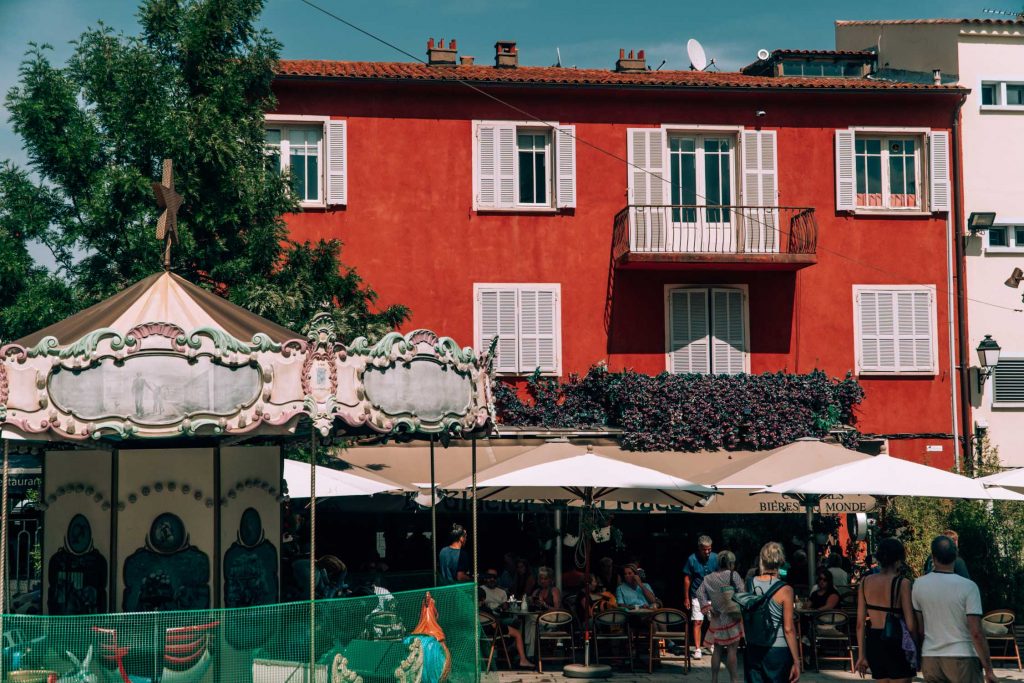
What to Do in Porto-Vecchio
Even though the city has had a small population for most of its history, it was an important cog in the Genoese defense strategy. Which is why the city is full of beautiful monuments like the two forts called Bastion de France and Bastion San Antonia. You also cannot miss the old city gate, the Porte Genoise, Chapelle de la Sainte Croix or the Saint Jean-Baptiste church adorning the cityscape. Overall, just walking through its quaint streets is enough to satisfy your senses.
Once you are tired of all that walking around, then sit down for lunch or dinner at the Place de la République, the square that forms the heart of the city. Or follow in our footsteps, and make your way down to the harbor to eat sushi at Café La Marine, which was so fresh I half expected the fish to dance off my plate.


Porto-Vecchio’s coastline is equally stunning. Make your way to either Palombaggia or Santa Giulia beach, both perfect sandy beaches located in a lagoon with turquoise waters. Because the water is so clear here, you should bring your snorkel gear to explore the marine life surrounding the island.
The city’s main hub is its port, from which many boat tours leave as well. The waters around the southern coast of Corsica are full of tiny islands with authentic ecosystems. You could combine a day at the Santa Giulia beach with a snorkeling tour, for example. But my personal favorite is to combine sailing with good food, which you can do by booking this tour. You could also visit the Maddalena archipelago from Porto-Vecchio, which technically is part of Sardinia. Here, you can spot flamingos and snorkel in the crystal clear Mediterranean: an activity you should not miss out on!

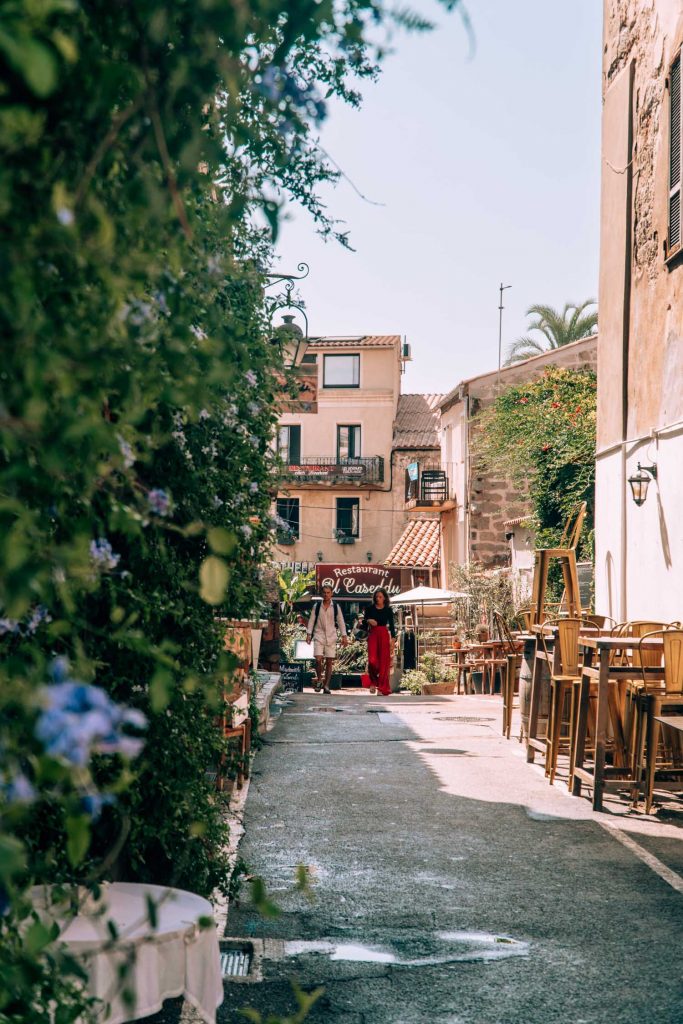
Where to Stay in Porto-Vecchio
You can stay right at the heart of the city at Holzer II, which has a little terrace out front on the street and rooms full of character. If you would rather enjoy the view on the hills surrounding Porto-Vecchio, than the boutique hotel La Balamina is to die for. But my favorite? Besides Domaine de Casanghjulina, which I mentioned earlier, Casa Santini x Roc Seven has a splendid view of the harbor and the sea, while offering tranquil rooms in a classic Corsican building.
9. Daytrip: Bonifacio
You cannot go to Corsica and not visit Bonifacio, which is why it is part of this East Corsica travel guide. Its citadel on white cliffs overlooking the sea still takes my breath away whenever I visit. As a kid I would drool whenever I saw the yachts and sailboats in the beautifully protected harbor dock or sail towards the sea, and as an adult I must confess I still do. As the southernmost point I incorporated it as a daytrip, as we cannot properly call it Eastern Corsica anymore, but as it is only a 35 minute drive from Porto-Vecchio it is doable.


What to Do in Bonifacio
Driving into Bonifacio, the first thing you will see is its harbor protected by the steep cliffs on either side. This made it the perfect fortress, and served as the first Genoese city when they took it. There is so much history here that checking out the marina, which now plays host to mostly wealthy travelers able to afford yacht trips, is something you cannot not do.
Then, make your way up to the citadel, where you will find the old city. It is quite a climb up, but once you reach the old city gate you enter a whole new world of adorable streets, cozy restaurants and artisanal shops. Make sure to take your time wandering through the city, eating at a restaurant or two and buying some souvenirs for your home! My number one tip, however, is to book a guided tour so you can fully grasp the history and cultural of this fortified city.

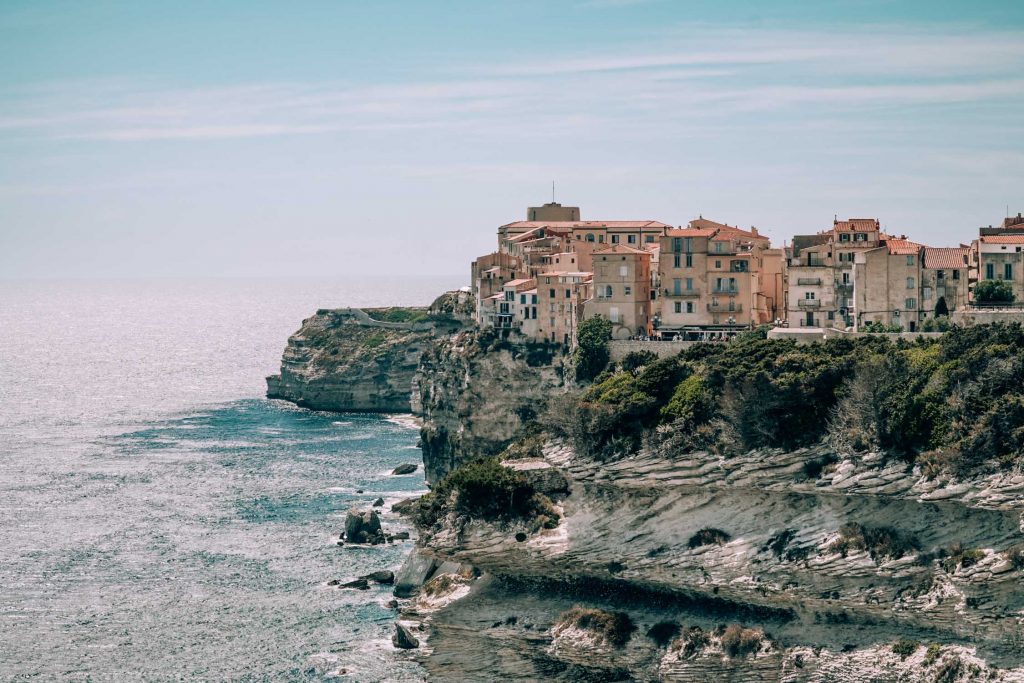
If you have had enough history and city life, then you should book a boat trip. Similar to Porto-Vecchio, the turquoise waters are omnipresent. From here, however, you can book a boat trip to the Lavezzi islands, also known as the breeding grounds for the Cory’s shearwater bird. For us, this was a day full of snorkeling, relaxing by the beach and taking in the stunning rock formations you can find on the islands. This one should be on your Corsican bucket list if you ask me!
Finally, there are a great number of pretty beaches surrounding Bonifacio, like: Petit Sperone, La Rondinara, Balistra and Canetto beaches. Here, you can go windsurfing when the weather is right or go kayaking along the coast. There is plenty to do in and around Bonifacio, so make sure to add this one to your itinerary.


Where to Stay in Bonifacio
A couple of years ago, my dad and I stayed at the Colomba Hôtel, a unique and quaint hotel in the center of the citadel. I remember the breakfast was incredible and the feeling of staying in such a town was unforgettable! If you rather stay somewhere a little more modern and prefer your hotels with a spa, you could stay at Hotel & Spa Genovese, which is located on a cliff point within the citadel, but with epic views. Staying near the marina is also an option, however, for which I would recommend the stunning Hotel Solemare, which provides rooms overlooking the marina.
10. Daytrip: Calvi
Calvi, another citadel city, offers unobstructed views of the Monte Cinto and is known for its long sandy beach where tourists and locals alike relax. While Calvi has been inhabited for over fourthousand years, the Genoese built the impressive citadel, which, like Bonifacio, is located on a higher hill than the rest of the city. It is best to visit Calvi as a daytrip from Saint-Florent, but it could just as well be your first city on Corsica, as a ferry runs between Calvi and France.
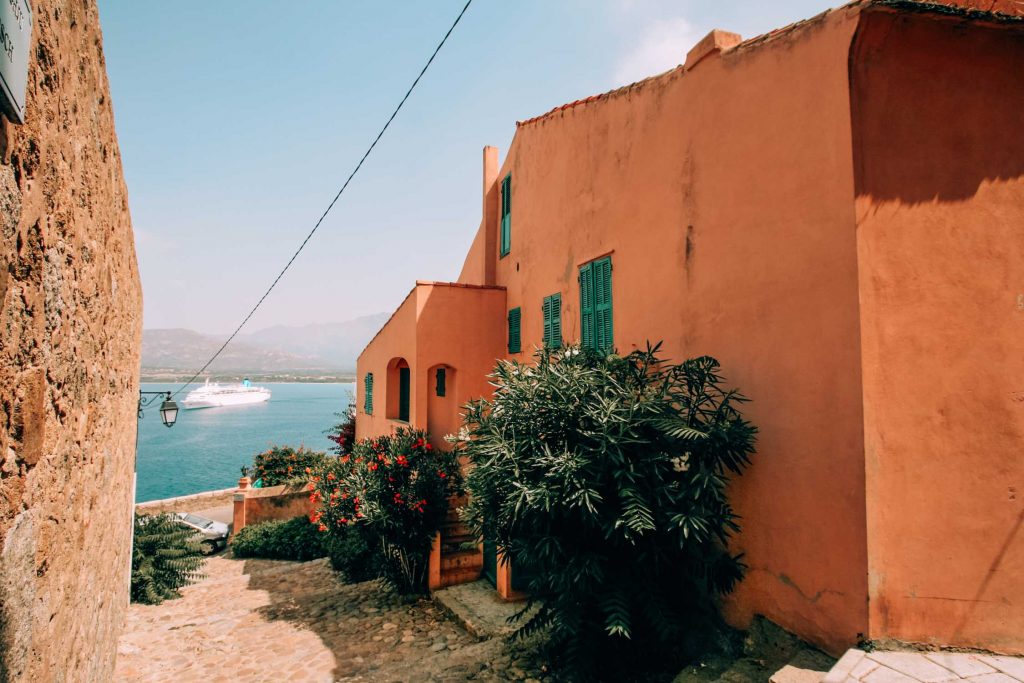

What to Do in Calvi
Like every Corsican city, Calvi has a rich history. The best thing to do is to book a guided walking tour of the city, so you will not leave any stone unturned. A tour like this will take you through the old citadel and end with a short food tour, so you can taste what Corsican cuisine is all about.
After visiting the citadel itself, you should make your way to the Notre Dame de la Serra, a chapel that offers splendid views of the bay of Calvi. You can hike up to the top, or take the more adventurous route and cycle up there. Either way, legend says if you make your way up with the one you love, you will have a wonderful life together. You could also choose to hike up the Capu di à Veta, the highest hill near Calvi, where you find a cross at the top. Either way, sunset views are known to be great at both spots.
Tip! Did you know Calvi is a wine region too? Read all about it in my Corsica Wine Tasting Guide
Besides its history, Calvi is also known for its long sandy beach called Plage du Roncu, which is a great place to relax after a day of exploring. My preferred mode of relaxation, however, is to do a wine tour in the area. Corsica has some great wines, and what better way to end your day than with a tasting at sunset?g
If you prefer to enjoy the views underwater however, then there are lots of diving tours around Calvi as well, which is a great destination for getting your PADI. I personally have not done it, but my dad and sister were very close to doing a dive somewhere around the island.
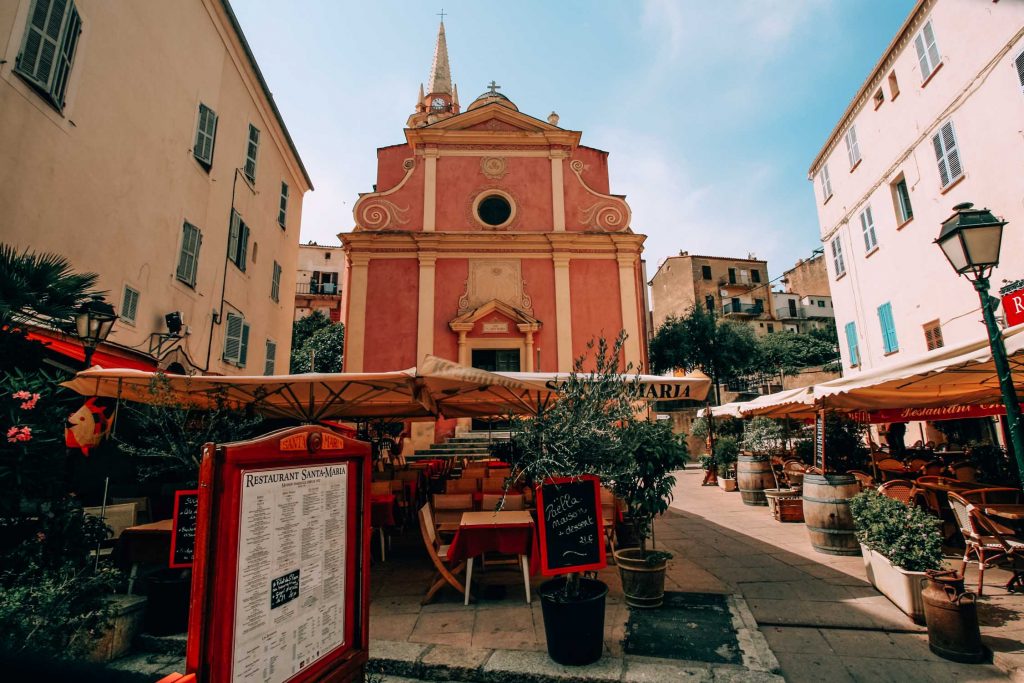
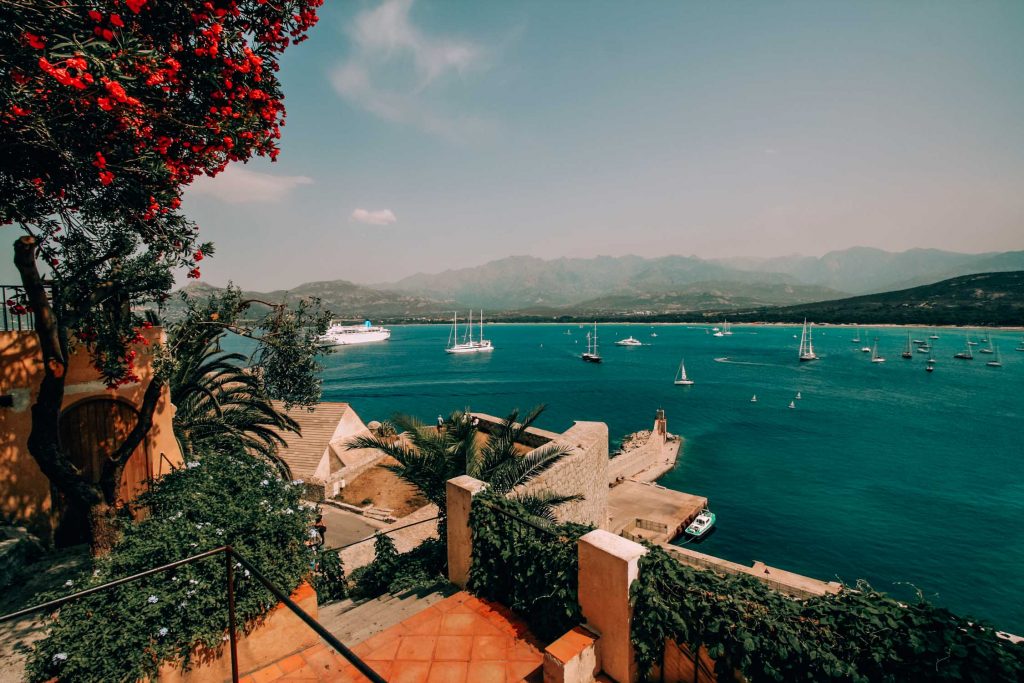
Where to Stay in Calvi
There are only a couple of accommodation options within the citadel of Calvi, the apartment Casa Santa being one of them. With a stunning view from the balcony you can have your café au lait in style here. For another spa treatment – Corsica sure loves its spa hotels – you should stay at Hotel Corsica & Spa, which is a little more remote but therefore has that serene vibe you look for in a wellness center. Another option is to stay in the new city of Calvi at the Hotel Balanea, which has classic and cozy rooms with views of the bay.
Final Thoughts
East Corsica is the island’s hidden gem and should not be skipped when traveling across the island. With cities and villages like Saint-Florent and Corte there is enough for both the beach bum, history buff and adventurous hiker. If you still want to see the west of Corsica though, then read my 3 week Corsica itinerary, which allows you to see the entirety of the island.
Want to know more about Corsica? Then sign up to my newsletter, or follow me on Instagram. In a couple of weeks, I will be sharing a full Corsica itinerary, and a gluten free guide to the island. In the meantime, read my other blogs on France, my Ultimate Corsica Wine Tasting Guide, this gluten free guide to Corsica or take a trip to Italy.




